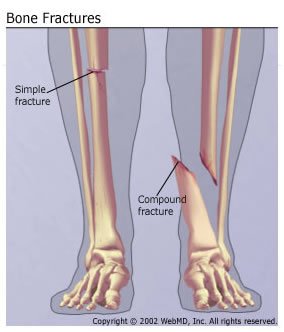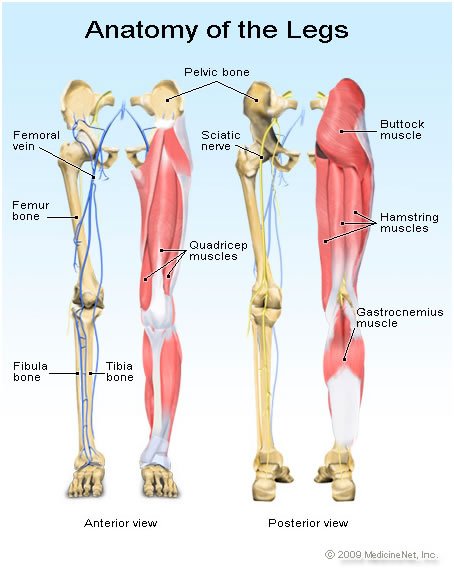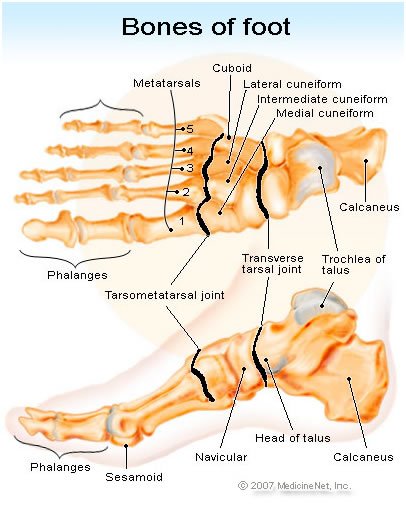| |
|
|
Understanding Bone Fractures, Diagnosis and Treatment
How Do I Know If I Have a Bone Fracture?
Doctors can usually recognize most fractures by examining the injury and taking X-rays.
Sometimes an X-ray will not show a fracture. This is especially common with some wrist fractures, hip fractures (especially in older people), and stress fractures. In these situations, your doctor may perform other tests, such as a computed tomography (CT) scan, magnetic resonance imaging (MRI), or a bone scan.
In some cases, such as a possible wrist fracture with an initially normal X-ray, your doctor may apply a splint to immobilize the area and order a second X-ray 10 to 14 days later.
 Occasionally, even after the fracture diagnosis has been made, you may need other tests (such as a CT scan, MRI, or angiogram, a special X-ray of blood vessels) to determine whether other tissues around the bone have been damaged.
Occasionally, even after the fracture diagnosis has been made, you may need other tests (such as a CT scan, MRI, or angiogram, a special X-ray of blood vessels) to determine whether other tissues around the bone have been damaged.
If your doctor suspects a skull fracture, he or she will probably skip plain X-rays altogether and proceed directly to a CT scan, which will diagnose the fracture and any more important related injuries inside the skull, such as bleeding around the brain.
What Are the Treatments for a Bone Fracture?
A fracture often requires emergency treatment at a hospital. An example of a minor fracture that may not require emergency care is a fracture of the tip of a toe. If you think that bones may be broken in the back, necks, or hip, do not move the person; instead, call for emergency medical assistance. If the person is in shock (faint, pale, or breathing shallowly), call for emergency help, lay the person down, and raise his or her legs about eight to 12 inches unless you think leg bones may be broken.
In other cases, you may call for assistance or transport the person to the emergency room. Before transporting the person, protect the injured area to avoid further damage. For broken arm or leg bones, put a splint (made of wood, plastic, metal, or another rigid material padded with gauze) against the area to prevent movement; wrap the splint to the area using gauze. If there is bleeding, apply pressure to stop bleeding before splinting, then elevate the fracture.
Fractured bones must be set in their proper place and held there in order to heal properly. Setting a bone is called "reduction." Repositioning bone without surgery is "closed reduction." Most fractures in children are treated with closed reduction. Serious fractures may require open reduction -- repositioning using surgery. In some cases, devices such as pins, plates, screws, rods, or glue are used to hold the fracture in place. Open fractures must also be cleaned thoroughly to avoid infection.
After setting, most fractures are immobilized with a cast, splint, or, occasionally, traction to reduce pain and help healing. In most cases, medication is limited to painkillers to reduce pain. In open fractures, antibiotics are administered to prevent infection. Rehabilitation begins as soon as possible, even if the bone is in a cast. This promotes blood flow, healing, maintenance of muscle tone, and helps prevent blood clots and stiffness.
|
Broken bone: Types of fractures, symptoms and prevention
Broken bones can happen after accidents, falls or being struck by something.
Broken bones are also called fractures, and can be very painful.
The risk of broken bones often depends partly on a person's age.
Broken bones can be common in childhood and older age.
Children's bones are still forming, plus they may fall off bikes or climbing frames for example.
In older age, people can become more frail and more likely to trip and fall. Plusosteoporosis can make bones more brittle and more likely to fracture after a fall.
Types of bone fracture
There are many types of fractures, but the main categories are complete, incomplete, compound and simple. Complete and incomplete fractures refer to the way the bone breaks. In a complete fracture, the bone snaps into two or more parts; in an incomplete fracture, the bone cracks but does not break all the way through.
In a compound fracture, also called an open fracture, the bone breaks through the skin. It may then recede back into the wound, so it is no longer visible through the skin. In a simple fracture, also called a closed fracture, the bone breaks but there is no open wound in the skin.

Simple fractures include:
• Greenstick fracture: an incomplete fracture in which the bone is bent. This type of fracture occurs most often in children.
• Transverse fracture: a fracture at a right angle to the bone's axis.
• Oblique fracture: a fracture in which the break is at an angle to the bone’s axis.
• Comminuted fracture: a fracture in which the bone fragments into several pieces.
• An impacted fracture is one whose ends are driven into each other. This commonly occurs with arm fractures in children and is sometimes known as a buckle fracture.
Among other types of fracture are: a pathological fracture, caused by a disease that weakens the bones; and a stress fracture, which is a hairline crack.
The severity of a fracture depends on its location and the damage done to the bone and nearby tissue. Serious fractures can have dangerous complications if they are not treated promptly, such as damage to blood vessels or nerves and infection of the bone (osteomyelitis) or surrounding tissue.
The recuperation time after a fracture varies depending on the age and health of the patient and the type of fracture. A minor fracture in a child may heal within a few weeks; a serious fracture in an older person may take months to heal.
What are the symptoms of a bone fracture?
Signs and symptoms of a fracture include:
• Swelling or bruising over a bone.
• Deformity of an arm or leg.
• Pain in the injured area that gets worse when the area is moved or pressure is applied.
• Loss of function in the injured area.
• In compound fractures, bone protruding from the skin.
Fractures are usually caused by a fall, blow or other traumatic event. Pathological fractures are those caused by disease that weakens the bones; they can occur with little or no trauma. Osteoporosis, a disorder in which the bones thin and lose strength as they age and causes.
Bone cancer is another disease that may lead to pathological fractures.
Seek medical attention if you think you may have fractured a bone. This is a medical emergency
What about surgery for a broken bone?
The decision to operate on a fracture depends upon the type of fracture, whether it can heal in good alignment on its own, and whether other potential complications exist.
Sometimes patients are taken to the operating room for a closed reduction (resetting of the bone) and splinting of the fracture. When a fracture is markedly displaced and misaligned, it may be too painful to move or manipulated the bone without an anesthetic.
If it appears that the fracture is unstable and cannot be held in place and in good alignment with just a splint or cast, an open reduction and internal fixation (ORIF) may be needed. An incision is made so that the bony pieces can be identified and aligned. Metal plates and screws, wires or rods may be used to stabilize the fracture. The hardware may be left in place forever or it may be there only temporarily until the fracture heals. Hip fractures almost always require ORIF to allow the patient to heal and regain the ability to walk.
Surgery may be required in situations where there is associated injury to arteries and nerves and they need to be repaired or decompressed.
 Open fractures often have to go to the operating room to be washed out to prevent infection of the bone (osteomyelitis).
Open fractures often have to go to the operating room to be washed out to prevent infection of the bone (osteomyelitis).
How can fractures be prevented?
Many broken bones occur because of accidents in the home, at work or at play, and not all may be preventable. Using proper safety equipment and precautions may minimize the risk of injury, but it cannot be completely eliminated.
As we age, there is an increased risk for falls at homes and some preventive steps may help reduce fall risks. These include:
• Make certain that lighting is adequate
• Shoes should not be slippery
• Loose rugs or uneven floors should be repaired
• High traffic areas like from the bed to the bath or from the kitchen to the living area need to be clear from hazards like excess furniture, extension cords, or boxes
• Bathrooms should have nonslip mats on the floor and in the bathtub or shower
• Install handrails for stairs and grab bars in the bathroom
Bones also get old as we age and the management of osteoporosis is a life-long commitment. Increasing calcium content in bone will decrease the risk of spontaneous fracture, and also may make bone strong enough to potentially withstand an injury that otherwise would result in a fracture. Ways to prevent osteoporosis include:
• Increase weight bearing exercise
• Make sure you are getting the right amount of calcium and Vitamin D in the diet. Take supplements if necessary.
• Do not smoke
• Avoid excess alcohol intake
|
|
|
|
|
|
|